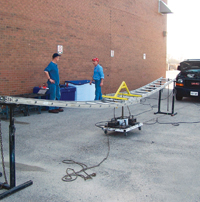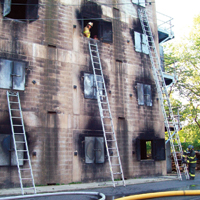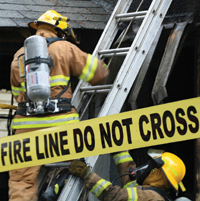
Features
Training
Back to Basics: September 2009
In August we introduced the concept of truck company operations. We identified the 10 functions within which a truck company operates and looked at some simple tips on overhaul operations. A big part of truck company operations is ladders, especially ground ladders.
September 14, 2009
By Mark van der Feyst
In August we introduced the concept of truck company operations. We identified the 10 functions within which a truck company operates and looked at some simple tips on overhaul operations. A big part of truck company operations is ladders, especially ground ladders. Every fire apparatus is equipped with at least two ground ladders – a straight, single roof ladder and an extension ladder. This is mandated by NFPA standards for apparatus specifications. Ground ladders have an NFPA standard – 1931 – detailing what is required and how they are to be constructed. These standards are not the most interesting reading material but they do contain some important information that we need to know as part of the basics. For instance:
- The heat sensor labels that are found on the inside of the ladder beam are preset for 300 F;
- An attic ladder will be no longer than 16 feet;
- The minimum distance between beams for single ladders will be 16 inches;
- The minimum distance between beams for an attic ladder will be no less than 7.5 inches.
 |
|
| Photo 1: In the horizontal bending test, a load of 750 pounds is applied to the middle of the ground ladder. Photo by Mark Van der Feyst |
|
 |
|
| Photo 2: Crews should practise laddering windows to various storeys to learn the limits of their ground ladders. Photo by Mark Van der Feyst |
|
 |
|
| Knowing ladder heights is crucial to effective rescue. Photo by Mark Van der Feyst |
All ground ladders are tested to ensure that they meet the NFPA 1931 standard. Most of us have never witnessed these tests being conducted but they are intrusive and are designed to test the extreme limits of the ground ladder. In photo 1, we see a ground ladder undergoing the horizontal bending test. In this test, a load of 750 pounds is applied to the middle of the ladder. Notice that the ground ladder is fully extended. It is supported by two stands at least six inches from each end of the ladder. The test uses 750 pounds for weight because NFPA 1931 requires that all combination, single and roof ladders – as well as extension ladders – are to have a duty rating of 750 pounds when raised at a 75-degree angle. Any test being conducted on a ladder will maintain a five-minute time limit. Notice how the ladder is bending under the test weight. There is probably a one-foot deflection under this extreme weight. But is this an extreme weight limit? If we were to use a ground ladder to rescue a civilian there is a good chance that the ladder would endure some extreme weight. The average weight of a firefighter fully donned with PPE is 300 pounds. This is a figure that NFPA uses to assess firefighter activity weight for any operation. One firefighter on a ground ladder trying to rescue a civilian who may weigh as much as 300 pounds is putting 600 pounds of weight on the ladder. Depending on the behaviour of the civilian, the ground ladder is likely to bounce as the rescuer and civilian descend. We need to know this to build our trust in the ground ladder. The ladder is designed to work under stressful situations and has proven on many occasions to be a very effective tool.
We also need to know the lengths of the ladders we carry on our apparatus. This is so that when it’s time to ladder a second-storey window we can pull off the correct ladder and raise it to the correct height the first time. Nothing looks worse than watching two firefighters raising and lowering a ground ladder trying to select the proper height. If we know our ladder lengths, the average distances between floors, the height of windowsills from the floor, the distance between rungs and how much a ladder tip will drop when we pull the base away from the wall, we can estimate correctly the height to which the ladder should be raised the first time.
In photo 2, three different ladders are being used to access different windows at different levels of a building – a 12-foot ladder accessing the second storey, a 24-foot extension ladder accessing the third storey and a 32-foot ladder accessing the fourth storey.
We know that in a typical structure the height between floors is 10 feet. The windowsill will be about three feet from the floor. This gives us a total height of 13 feet to reach. If we grab a 14-foot roof ladder, will it reach the windowsill? Yes, it will. A ladder, when moved away from the wall, will drop one foot for every four feet of horizontal movement. When a 14-foot roof ladder is moved away from the wall to the correct climbing angle, it will have a vertical height of 13 feet. A 12-foot roof ladder would also work. It would be about 18 inches below the windowsill but it would still allow us to gain access or rescue a civilian.
Our extension ladders are usually 24 feet. The bed of the 24-foot ladder measures 14 feet. Rungs on the ladder are about 12 inches apart. When we extend the fly section of the ladder, we need to count the number of clicks from the dogs to raise the ladder to the correct height. A 24-foot ladder fully extended will measure 24 feet. We can then theoretically reach a third-storey window with a 24-foot ladder, having a vertical height of 23 feet from ladder tip to the ground. We need to consider other factors such as raised basements and sloping surfaces. This will add to the total height we need to reach.
The best way to learn the limits of ground ladders is to practise with them. Use buildings in your area and ladder the windows on different storeys. Ask the crew to estimate how high the ladder must be raised to reach certain windows. Your crew can practise estimating ladder heights to learn the limits of each ladder. Crew members will also know which ladders to use to reach certain windows if they get called to that building.
Mark van der Feyst is a 10-year veteran of the fire service and he works for the City of Woodstock Fire Department. He is an international instructor teaching in Canada and the U.S. Mark is a local level suppression instructor for the Pennsylvania State Fire Academy and an Instructor for the Justice Institute of B.C. He can be reached at Mark@FireStarTraining.com
Print this page